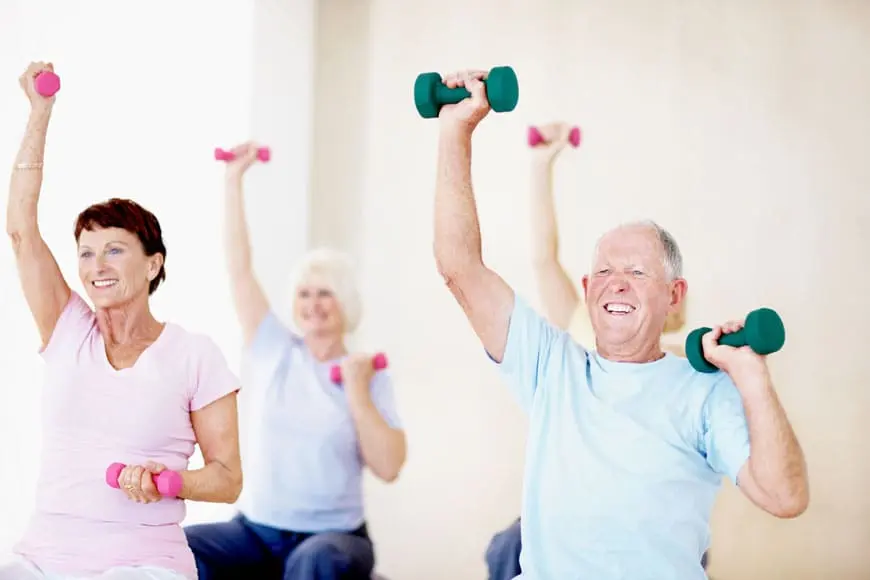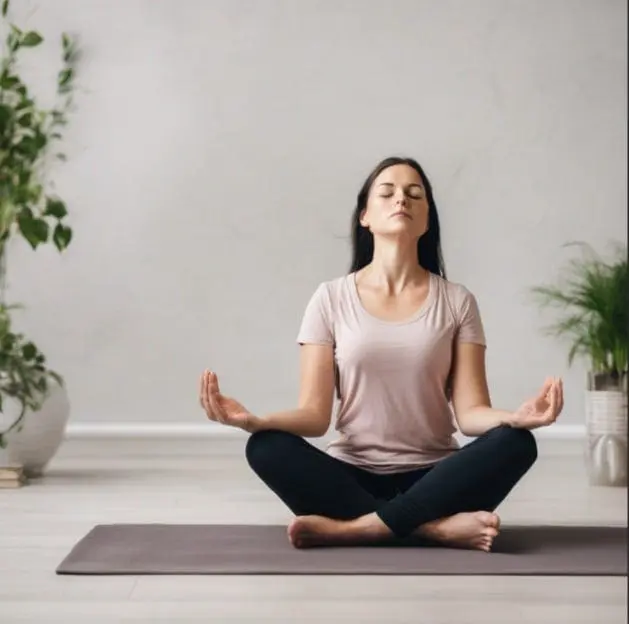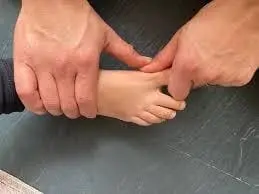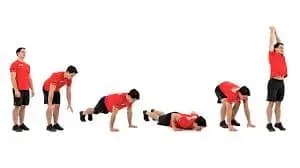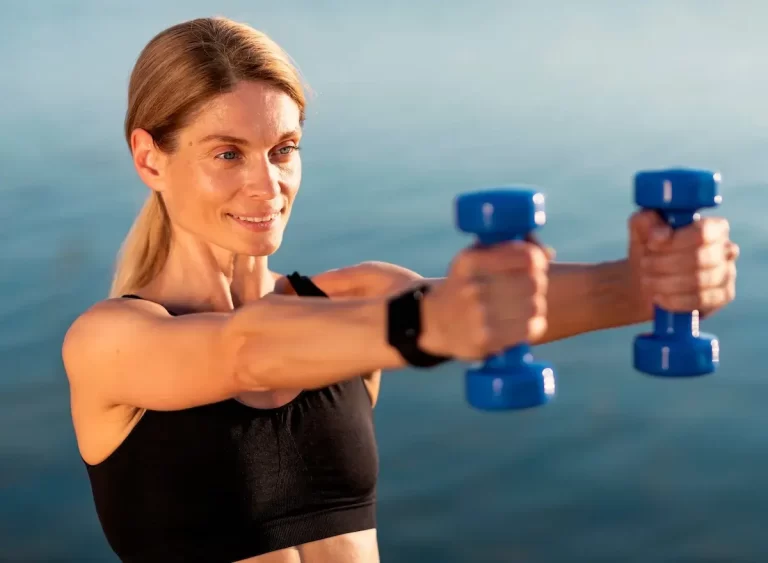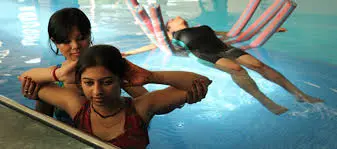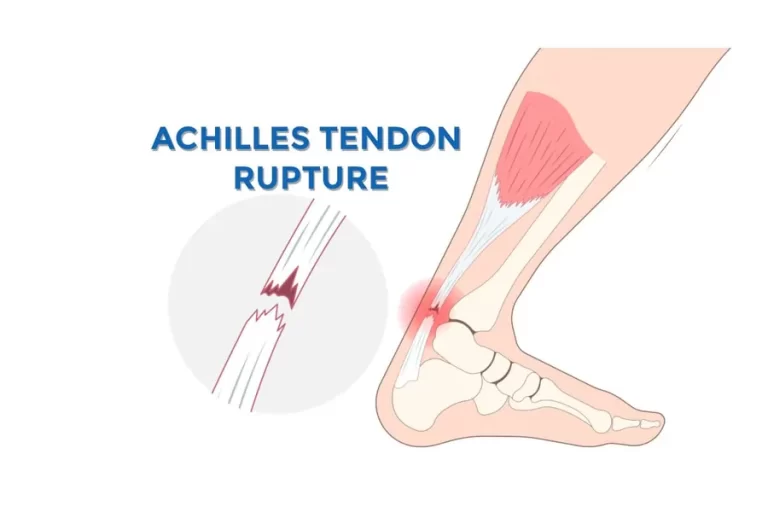33 Best Exercises for Osteoporosis
Exercise and regular physical activity are important for keeping bones strong. Exercise has been accepted as a successful lifestyle tactic to develop a strong bone and preserve bone strength over time. Muscles become larger, stronger, and more capable with exercise. It’s never too late to start exercising.
Regular exercise lowers the risk of fractures by slowing the pace of bone loss and conserving bone tissue. If you have osteoporosis, it’s necessary to decide on the safest and most enjoyable ways to exercise for the level of bone loss and overall health.
What is osteoporosis?
The condition known as osteoporosis is caused by fragile, weak bones that are at risk of breaking. The high concentrations of minerals in normal, healthy, and strong bones are the source of their strength. Bone mineral density (BMD) is the measure of the minerals present in our bones.
Our bones are continually undergoing the rebuilding process, reorganization, and destruction. When our bones break down faster than they can be rebuilt, our bone mineral density decreases.
As we get older, our Density gradually drops, beginning in our 20s. If there is an excessive loss of minerals from the bone, osteoporosis is going to happen and our bone mineral density will drop significantly.
Introduction:
For those who already have osteoporosis, exercise can be advantageous. This is due to living an active lifestyle while getting less physical activity encourages bone loss. Exercise can strengthen bones and can also help to slow down the process of bone loss.
The majority of bone fracture incidents involve falls. By working out to build muscle and improve your balance, you can lower your chance of falling. Exercise can slow down the rate of bone loss and reduce the risk of osteoporosis-related fractures.
For those who already have osteoporosis or want to avoid it, exercise has additional benefits. These include better treatment of other medical conditions and a decreased requirement for certain medications that increase the risk of falls.
A higher risk of a broken bone could happen in individuals with more severe osteoporosis. They could become prevented from engaging in particular workouts. Find out if you have a higher risk of osteoporosis-related issues by speaking with your physical therapist or primary care physician. Recognize the exercises that work best for you.
Symptoms of Osteoporosis:
Even if your bones feel fine, it’s still important to discuss osteoporosis with your doctor. The term “silent” disease is often applied to osteoporosis, but if your bones have weakened, you may experience the following symptoms.
- Pain in the back
- A decrease in height
- Hunched over (kyphosis)
- Broken bones (fractures are possible, for example, from falling from a height, bending over, or lifting anything)
Exercise’s advantages for osteoporosis individuals:
Fractures are more common in people who lead sedentary lifestyles and have weak muscles, poor posture, and poor balance. Exercise has many beneficial effects on a person with osteoporosis’s health, including;
- Minimizing bone loss
- Protection of the remaining bone mass
- Improved coordination and balance
- Increased level of physical fitness
- Increased strength in the muscles
- Improved responsiveness
- Improved mobility
- Decreased chance of bone fractures from falls
- Reduced pain
- Improve your posture
- Increased energy and mood.
Considering an exercise program for people with osteoporosis:
Consultation with a physician or physiotherapist is usually a good idea earlier than starting a physical activity program. Some factors that must be taken into thought are:
- How old you are
- How severe your osteoporosis is
- The medications you take now
- Your level of ability and fitness
- Other illnesses including neurological issues, arthritis, or diseases of the heart or lungs
- The major goal of your exercise program should be to increase bone density or reduce your risk of falling.
The ideal program includes weight-bearing impact training, aerobic, muscle-building (resistance), and targeted balance exercises.
For those who have osteoporosis, the following activities are advised:
The activities listed below are helpful for those who have osteoporosis:
- Impact-loading, weight-bearing physical activity such as aerobics.
- Resistance training with body weight resistance, elastic band resistance, free weights like dumbbells, or weight-training equipment.
- Exercises that improve physical strength, balance, and posture include yoga and tai chi.
Weekly physical exercise needs to include activities from each of the three categories.
Selecting the Proper Exercise Type:
It is commonly recommended that individuals with osteoporosis take part in these kinds of exercises;
- Walking
Increasing bone density and lowering fracture risk are two ways that walking, a low-impact aerobic exercise, may prevent osteoporosis. Walking improves balance, strength, and coordination, all of which could decrease the chance of falling.
An alternate weight-bearing exercise that keeps up bone health and improves the development of bones is walking. Walking has numerous health advantages, but it may also improve mood by reducing stress and anxiety, releasing endorphins, and elevating mood.
This is a simple exercise that you can do outside, with friends or family, or by yourself. Walking regularly helps strengthen bones in people with osteoporosis.
- Posture exercises for osteoporosis
An increased risk of spinal compression fractures and higher bone stress can result from poor posture. In addition to making sure that the exercises are safe and suitable for someone with weakened bones, osteoporosis patients should concentrate on strengthening the muscles that promote proper posture, such as the back extensor muscles and the abdominal muscles, or core.
- Aerobic exercises involving weight-bearing
During weight-bearing aerobic exercise, you maintain your body weight on your feet while participating in aerobic activity. A few examples include gardening, stair climbing, low-impact aerobics, and cardio workouts.
These exercises, particularly prevent bone loss, primarily target the lower back, hips, and legs. They also improve blood flow and are beneficial to the heart.
You should exercise in other ways as well, considering that aerobic exercise is good for your general health. Gaining balance, strength, and flexibility is also important.
- Workouts for flexibility.
Effective muscle action gets better when joints are kept in their full range of motion. Performing stretches after your muscles have warmed up is recommended. For instance, stretching is beneficial right after a ten-minute warm-up or following exercise. Stretching must be done gently, without jumping, and slowly.
Avoid doing stretches that make you bend at the waist or along your spine. The doctor who treats you should be consulted about which are suitable stretching exercises for you.
- Exercises for balance and stability.
Fall prevention measures are particularly important for those who have osteoporosis. Exercises for balance and stability help muscles cooperate in a way that reduces the possibility of falls. Simple movement-based exercises like yoga, tai chi, and one-leg stand-ups are effective techniques to improve stability and balance.
- Exercises focusing on strength, particularly those targeting the upper back.
To improve your muscles, tendons, and bones, try strength training with free weights, resistance bands, or your body weight. Strength training is especially helpful for building back muscles that are necessary for proper posture. Additionally, it may support bone density.
Strength exercises should be personalized to your capacity and comfort level, particularly if you are in pain. It is beneficial to consult with a personal trainer or physical therapist who has worked with osteoporosis patients in the past. They can help you create a routine of exercise focused on strengthening your body. They may also teach you how to perform exercises with the best form and technique possible to avoid injuries and maximize your results.
Tips for exercising safely if you have osteoporosis:
Exercise can be very helpful to people with osteoporosis, but precautions must be followed to reduce the risk of fractures or other injuries.
- Taking care of stability
Before trying more challenging activities, someone who is not used to exercising should make sure they are strong enough to maintain balance and stability.
- Dressing comfortably
Exercise may be better if you wear supportive shoes and comfortable clothing.
- Locating the space
Make sure that the space is in the right temperature range and that there is enough space for exercising.
- Getting warm and cooled down
This could alleviate the pain in your muscles. To warm up, begin with a gentle, frequent activity like walking for a few minutes or slowly going through a few weight-training exercises without the use of weights. Your muscles receive more blood as a result, which lowers the possibility of damage.
- Increase progressively
Begin with lower-intensity, easier exercises.
- Avoid holding your breath
While performing these exercises, keep your breathing continuous. For instance, inhale deeply, release the air gradually as you raise the weight, then inhale again as you lower it. Both when lifting and lowering the weight, breathe normally.
- You should not experience pain
While performing these exercises with weights, you should be putting in a lot of effort, but keep in mind to just move as far as it does not hurt you.
The Best Effective Exercises for Osteoporosis:
These are the best exercises for developing stronger muscles and bones.
Hip extension
- First, find a comfortable spot on the ground to stand.
- Extend your arms out in front of you and hold onto a wall, chair, or table for support.
- Raise the left leg backward without bending the knee, keeping the right leg straight.
- Squeeze the buttock lightly after raising the leg as high as you can without hurting it.
- Hold this position for a few seconds.
- Then return to your neutral position.
- Then relax.
- For each leg, perform this exercise five to ten times.
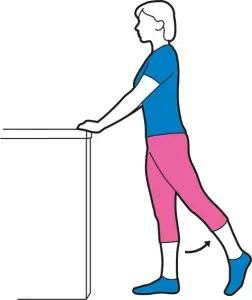
Bridging
- With both legs bent at the knees and your feet flat on the ground, lie comfortably on your back.
- Keep your arms by your sides and your hands facing downwards.
- Put a little pillow under your head and neck when you need support.
- Lift your back after gradually lifting your pelvis.
- Maintain your upper body and shoulders planted on the ground.
- Hold that posture for a few seconds.
- From the start at the top of the spine, gradually bring down the pelvis and move it back toward the ground.
- Once again, place your entire back on the floor by lowering into your spine.
- Then return to your neutral position.
- Then relax.
- Perform this workout five or ten times.
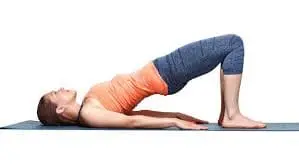
Bicep curls
- These can be done standing or sitting, depending on how comfortable you are.
- Grab a dumbbell with both hands.
- Allow your arms to be rested loosely by your sides, with your palms facing forward.
- As you extend the weights to almost shoulder level, have a straight upper body and comfortable shoulders.
- Alternatively, raise the dumbbells to your forehead or eyeballs for a complete range of motion.
- Then return to your neutral position.
- Then relax.
- Work out for five to ten repetitions.
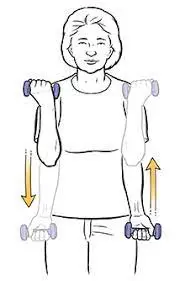
Hamstring curl
- Place your feet hip-width apart while standing.
- To maintain balance, rest your hands on your waist or a chair.
- Put more weight on your left leg.
- When your heel touches your butt, carefully bend your right knee.
- Make sure your thighs are parallel.
- Hold this position for a few seconds.
- Lower your foot gradually.
- Then return to your neutral position.
- Then relax.
- Repeat this workout five or ten times.
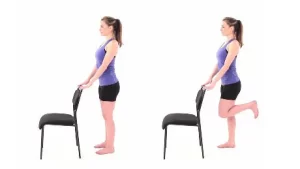
Squats
- Place your feet hip-width apart to begin.
- Carefully place your hands on a sturdy chair or other piece of equipment for support.
- To lower yourself slowly, bend at the knees.
- To feel the movement of your legs, bend forwards slightly while keeping your back straight.
- Before lowering down, make sure your thighs are straight to the floor.
- To get back to a standing position, squeeze your buttocks.
- Then return to your neutral position.
- Then relax.
- Follow this workout five or ten times.
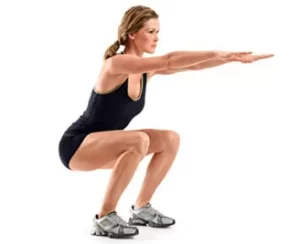
Calf stretch
- Hold onto a table or chair or any other sturdy surface when you stand.
- Reverse the leg to the right.
- Bend your left knee forward gently.
- Verify that the back is straight and that both feet’ heels are on the ground.
- The right calf should be stretched in the back.
- Hold this position for a few seconds.
- Then return to your neutral position.
- Then relax.
- You should perform this exercise between five and ten times every day.
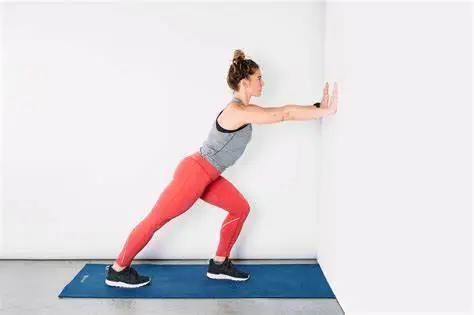
Clamshells
- Lay on your side with your forearm resting on the floor and your knees bent at a 45-degree angle.
- Make sure that your hips are arranged one above the other.
- Your ankles and feet have to come into contact.
- Squeeze your belly button in the direction of your spine to activate your core.
- Lift your upper leg as high as you can without shaking your hips or pelvis while maintaining your feet together.
- Hold this position for a few seconds.
- Then return to your neutral position.
- Then relax.
- Perform this workout five or ten times.
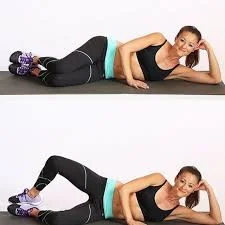
Side-lying leg lifts
- Lie flat on your side with your legs extended and placed above one another.
- Your feet, ankles, knees, and hips should all line up.
- On the floor, place your forearm.
- Alternatively, bend your arm and hold your head in your hand.
- Squeeze your abs by pressing your belly button toward your spine.
- Raise your upper leg toward the ceiling and see how your abdominal muscles are stretched.
- Hold this position for a few seconds.
- Return your upper leg to its starting position slowly.
- Then relax.
- This workout should be done five to ten times.
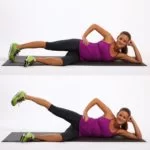
Sit-to-stand
- Having your knees bent and your feet flat on the ground, take an upright position in a firm chair.
- With your feet hip-width apart, take a seat closer to the chair’s edge.
- Cover your body gently with both hands.
- Alternatively, to increase the effect, put your arms across your chest.
- Tighten the muscles in your abdomen to engage your core.
- To get up without using your hands, bend forward and push through your legs.
- To sit down, gently press your hips back while maintaining your core engaged.
- Take careful, planned actions to prevent “plopping” or falling back into the chair.
- Then relax.
- Perform this exercise five to ten times.
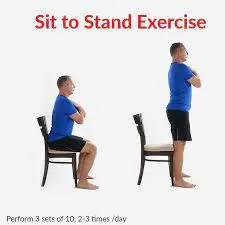
Step-ups
- Place yourself in front of a strong exercise step platform.
- To straighten your right leg, step up with your right foot and push into your heel.
- To meet the right foot, raise your left foot to the step.
- Step down with your left foot first, then your right, bending your right knee.
- Then return to your neutral position.
- Then relax.
- This workout should be done five to ten times.
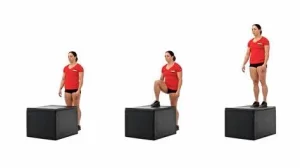
Triceps lift
- Sitting in a chair or bench, keep your back against the seat’s back and your feet flat on the floor.
- Maintain a straight posture.
- Bend your elbows slightly as you lift your arms to each side of your head.
- Instead of bending your head forward, bend one elbow so that your wrist lowers to the base of your neck.
- Raise your hand slowly while holding it until it is parallel to the wrist of the person on the other side.
- Hold this position for a few seconds.
- Then return to your neutral position.
- Then relax.
- Work out for five to ten repetitions.
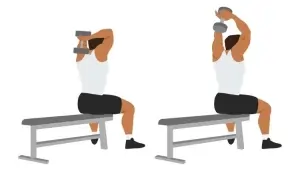
Knee extensions
- Place your feet flat on the floor and relax back on your chair to support your lower body.
- To maintain balance, hold the seat’s sides.
- Lift one foot gradually forward, maintaining your thigh on the chair and attempting to straighten your knee as much as you can.
- Hold this position for a few seconds.
- Slowly lower your leg.
- Then return to your neutral position.
- Then relax.
- Complete this workout five to ten times.
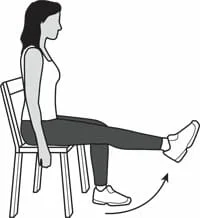
Standing Side Leg Raise
- Put your hand down for balance when standing with one side facing a stable object, such as a table, chair, or countertop.
- Raise the other leg out to the side while keeping your leg straight and your toes pointed forward, not upward toward the ceiling.
- Focus on contracting your glute and hip muscles as you hold at the top of the exercise.
- Return your leg to its starting position gradually.
- You should feel the muscles in your butt, thigh, and hips activating with each repetition.
- Then relax.
- Repeat five to ten repetitions of this workout.
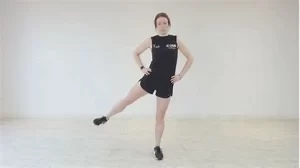
Pelvic Tilt
- Put your feet flat on the floor and your knees bent, and lie on your back.
- Your lower back should be gently raised off the floor in this position by the natural curve of your spine.
- Breathe in, then out slowly.
- Your lower back should press into the floor and the muscles under your fingertips should tense as you release the breath.
- Tilt your pelvis upward, as if you are pushing your belly button into your spine.
- Then return to your neutral position.
- Then relax.
- Repeat this workout five or ten times.
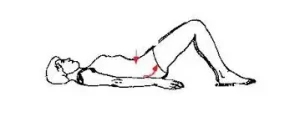
Superman Back Extension
- Lie down on your abdomen.
- If you need support, place a little pillow under your hips.
- Lift your arms above your head.
- Slowly raise your legs and arms a few inches off the ground.
- Hold this position for a few seconds.
- Then return to your neutral position.
- Then relax.
- Work out for five to ten repetitions.
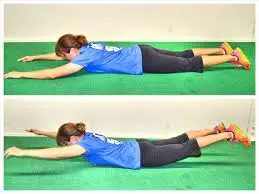
Bird Dog Exercise
- Lie down on your hands and knees.
- By looking at the ground between your hands, maintain a straight neck.
- Raise and extend your right arm straight ahead of you.
- As you raise your leg to be level with the floor, gradually raise your left knee.
- Hold this position for a few seconds.
- Then return to your neutral position.
- Then relax.
- This workout should be done five to ten times.
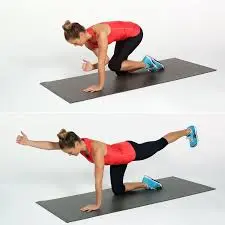
Heel raise
- To provide support, straighten your shoulders and rest your hands on the back of a sturdy chair.
- Raise your heels off the ground gradually.
- Maintaining a straight knee.
- Hold this position for a few seconds.
- Next, bring your heels down to the floor.
- Then relax.
- Repeat this exercise five to ten times.
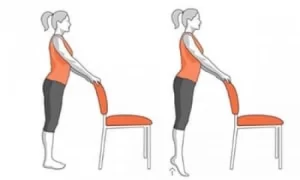
Toe rise
- Begin in a comfortable standing position.
- As support, you can rely on a chair or the wall.
- Raise your toes now.
- Hold this position for a few seconds.
- Then lower your toes.
- Return to your neutral position after that.
- Then relax.
- Perform this exercise five to ten times.
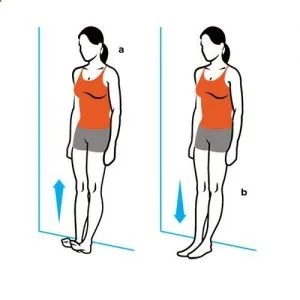
Wall Slide
- Position your feet shoulder-width apart and your heels away from the wall.
- Put your shoulders, buttocks, and palms of your hands against the wall.
- Pull your chin in and try to keep the back of your head as near to the wall as you can.
- As you slide along the wall, keep your core tight.
- Bend your knees halfway or a quarter to sit, then slide back up.
- Maintain a flat back and shoulders.
- Then return to your neutral position.
- Then relax.
- Working out for five to ten repetitions.
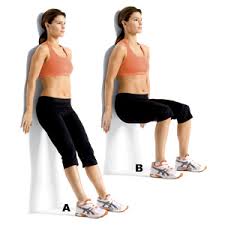
Prone leg raise
- Lying on your stomach on the ground, extend your legs straight and keep your hands by the sides of your body.
- With your foot relaxed, raise your right leg slightly off the ground.
- Hold this position for a few seconds.
- Slowly lower your leg.
- Then return to your neutral position.
- Then relax.
- Repeat five or ten repetitions of this workout.
Shoulder blade squeeze
- With your neck and back straight, take a standing position on the ground.
- Plant your feet firmly on the ground.
- Keep your eyes straight ahead.
- Arms should be bent at the elbows.
- As far as you can comfortably move your elbows and shoulder blades back, do so gently.
- Hold this position for a few seconds.
- Take a regular breath.
- Then return to your neutral position.
- Then relax.
- Complete this workout five to 10 times.
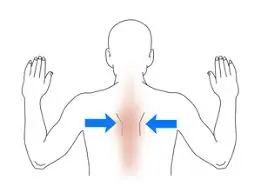
Chin tuck
- Try to sit or stand as straight as you can.
- Keeping your head as straight as you can and placing your ears directly above your shoulders, look up front.
- You can lightly press your finger against the chin.
- With your head toward the back, begin pulling down your chin.
- In this phase, the area where your head connects to your neck should feel slightly stretched.
- Hold this position for a few seconds.
- Then return to your neutral position.
- Then relax.
- Work out for five to ten repetitions.
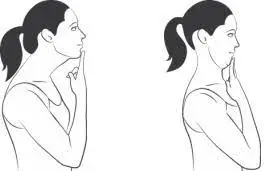
Wall pushup
- Place your feet hip-width apart and stand around arm’s length away from the wall.
- With your fingers pointing upward, place both hands on the wall about shoulder-width apart and at a height equal to your shoulders.
- Place your feet closer to the wall if you think you’re reaching too far.
- Move your body toward the wall, bending your elbows slowly until your nose nearly touches it.
- Maintain a straight back and bend your elbows at a 45-degree angle (rather than straight to the sides).
- Hold this position for a few seconds.
- Then return to your neutral position.
- Then relax.
- This workout should be done five to ten times.
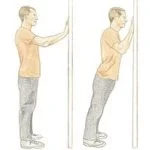
Bow and arrow pull exercise
- Maintain a straight back when standing upright position on the ground.
- Grab the elastic with both hands and raise your arms to your shoulders.
- Maintain a straight and stable left arm.
- Bending at the elbow, raise your right arm to a 90-degree angle with your body, then pull it back.
- Hold this position for a few seconds.
- Then return to your neutral position.
- Then relax.
- Perform this exercise five to ten times.
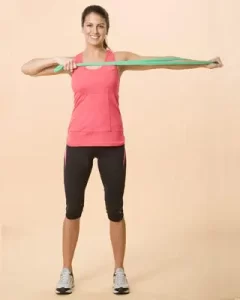
The Overhead pull exercise
- Put your feet flat on the floor, and bend your knees while lying on your back.
- Using both hands, hold onto the exercise band at each end.
- Put your arms over your shoulders, keep your elbows completely straight, and raise your thumbs to the top of your head.
- Pull the band apart by separating your hands until the band experiences a moderate level of resistance.
- Lift both arms above till your thumbs touch the floor, or as high as you can safely go while maintaining your grip on the band.
- Hold this position for a few seconds.
- Then return to your neutral position.
- Then relax.
- Work out for five to ten repetitions.
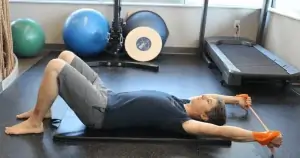
Knee Lift
- With your knees bent, feet flat on the ground, and arms by your sides, lie on your back.
- By pulling in the belly button and pressing the lower back gently into the floor, you can tighten your abdominal muscles.
- Raise the leg to a 90-degree angle.
- Hold this position for a few seconds.
- lower your leg gradually, maintaining your lower back pressed against the ground.
- Then return to your neutral position.
- Then relax.
- Repeat five or ten repetitions of this workout.
Plank (on chair)
- Facing a sturdy chair, put your hands hip-width apart and your arms at your sides.
- Lower your upper body toward the chair with your palms resting on the seat.
- They have to be just below your shoulders.
- Stretch your legs straight out behind you while keeping your toes planted and your heels off the floor.
- Maintain an upright and straight back while keeping your core muscles stable.
- Maintain your focus down at the seat.
- You’ll be a little inclined in the body.
- As you gradually lower your chest to the seat, bend your elbows until they form a 90-degree angle.
- Until your elbows are stretched, push your body away from the chair.
- Then return to your neutral position.
- Then relax.
- Complete five to ten repetitions of this workout.
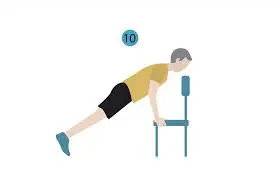
Hamstring stretch
- Stretch one leg out in front of you while keeping your heel flat on the ground and take a seat at a chair’s edge.
- Lower your chest toward the floor and flex your hips.
- Hold this position for a few seconds.
- Then return to your neutral position.
- Then relax.
- This exercise should be done five to ten times.
- As you perform each repetition, you should feel a stretch in your hips, calf, and back of your leg.
Standing march exercise
- With your feet hip-width apart, take a standing position.
- Raising your leg to a comfortable height, but not higher than hip level, while maintaining a tall stance, extend your other arm upwards.
- Hold this position for a few seconds.
- Return to the ground with your foot lower, then switch to the other leg.
- Stepping your feet as they hit the ground, keep marching forward.
- Then return to your neutral position.
- Then relax.
- Repeat five or ten repetitions of this workout.
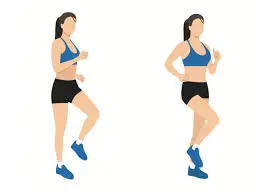
Doorway Stretch
- Step outside an open doorway.
- Stretch each arm out to the side, keeping your elbows 90 degrees bent and your palms facing forward.
- Hold the door frame with your hands.
- Try lowering your elbows a little bit if this is uncomfortable for you.
- Take one foot at a time and go forward carefully.
- Your shoulders and chest should feel stretched.
- Stay straight and avoid bending forward.
- Hold this position for a few seconds.
- Remain relaxed and take a step back.
- Then return to your neutral position.
- Then relax.
- Practice this workout five or ten times.
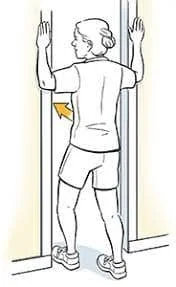
Standing Backward Bend
- Keep your arms by your sides and your feet together while standing straight.
- With your palms facing inward, raise your arms overhead while taking a deep breath.
- Exhale and slowly bend backward, pushing your pelvis forward, maintaining your elbows and knees straight ahead, and keeping your arms lined up with your ears.
- Raise your chest toward the ceiling while maintaining an upward posture.
- Take a deep breath and hold it.
- Inhale and rise once more.
- Release your breath, drop your arms, and relax.
- Then return to your neutral position.
- Then relax.
- Practice this workout five or ten times.
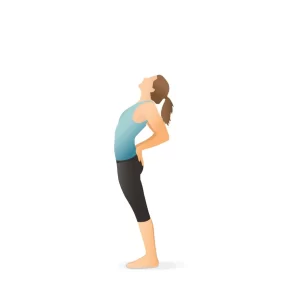
Arm Raise
- Take a seat in a chair.
- Hold dumbells in both hands.
- Place your feet flat on the ground, level with your shoulders.
- Arms parallel to the sides, palms facing inward.
- Raise both arms to the side, and up to the shoulder.
- Hold this position for a few seconds.
- Lower your arms to your sides slowly.
- Then return to your neutral position.
- Then relax.
- Practice this workout five or ten times.
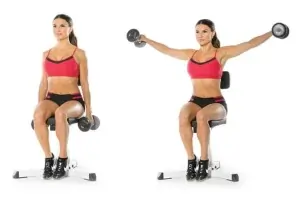
Hip Flexion
- Place yourself behind or to the side of a chair or table and use one hand to support yourself.
- Bend and bring your left knee as close to your chest as you can.
- Keep your posture straight and avoid bending at the hips or waist.
- Hold this position for a few seconds.
- At this point, firmly lower your left leg.
- Then return to your neutral position.
- Then relax.
- Practice this workout five or ten times.
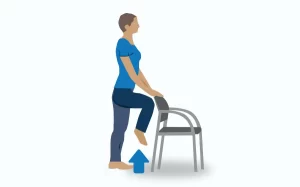
Water exercise and swimming for osteoporosis patients:
Place yourself behind or to the side of a chair or table and use one hand to support yourself. Aqua aerobics and hydrotherapy, as well as swimming, are examples of water activities that do not require weight bearing since the buoyant force of the water balances the effects of gravity. On the other hand, working out in the water can increase muscle strength and cardiovascular fitness.
People who are at high risk of bone fractures due to severe osteoporosis or kyphosis (hunching of the upper back) might realize that swimming or water exercise is their favorite type of exercise. Speak with your physician or another health care professional.
With osteoporosis, are yoga and pilates safe?
Both Pilates and yoga can support bone development when the exercises or poses include resistance, weight-bearing, and/or strengthening. But not every Pilates practice or yoga pose is suitable for someone who has osteoporosis. Avoiding some yoga and Pilates poses that cause the spine to round out (flexion), twist, or arch excessively (extension) might relieve pressure on the spinal bones, which, in people with weaker bones, are particularly susceptible to fractures caused by compression.
For example, if you have been diagnosed with osteoporosis, you should avoid positions that require you to bend forward or stretch your hips deeply, such as pigeon pose. But for people who already have strong, healthy bones, bone mineral density can be increased with yoga and pilates. Furthermore, yoga and pilates may be helpful for women with osteoporosis, at least for some of them, provided that the dangerous poses listed above are avoided.
In conclusion, Pilates and yoga can be advantageous to bone health, but only if they are performed properly and specific positions that place the bones in a riskier condition are avoided.
When should you stop exercising?
- Pain in the joints or swelling.
- You’re having fever
- Headache
- Exercise should be stopped if it hurts.
Exercises that people with osteoporosis should avoid:
In general, exercising with osteoporosis is safe. But it’s important to come up with an exercise program that protects your bones. Movements that put stress on weak bones should be avoided. This is particularly true for body parts like the spine that are more likely to fracture.
Individuals have to avoid from doing anything that;
- Involve heavy forward flexion of the spine, like toe touches and abdominal sit-ups.
- Increase the possibility of falling.
- Need a strong twisting motion, like a golf swing, unless the person is used to these kinds of motions.
- Exercises that break down bones, such as running, jumping, and jogging, can cause fractures.
- Those who have osteoporosis may be more vulnerable to spinal fractures when they bend forward or twist at the waist.
- Some poses from Pilates or yoga that may put pressure on the spine are the warrior I pose and the pigeon pose.
- Activities that can raise your risk of falling include skating and skiing.
If you have concerns about whether starting an exercise therapy is safe for you, communicate with your doctor. You may find out what to try and what to avoid.
Some suggestions for an effective bone-healthy exercise program:
- When first beginning, work together with a physiotherapist.
- Exercise must be frequent and a little intense for it to affect bone.
- Move slowly at first and quickly pick up speed.
- Exercise variation is beneficial for bone health because it builds bones in several ways, overcoming the benefits of repetition.
- Exercise needs to be done in quick, focused repetitions.
- Strength training should be done in short sessions rather than in larger ones.
Whether you have osteoporosis or not, you must maintain bone health over time by participating in a physical activity program. For the sake of your bones’ health, you should continue your long-term exercise program irrespective of if you have osteoporosis. Regular activity is the best way to get exercise.
Changes in Lifestyle Can Be Helpful:
Exercise using the following lifestyle protocols can help you reduce the risks and symptoms of osteoporosis:
- Consume a diet that includes vegetables, whole grains, and other healthful, nutrient-dense foods.
- Eat a lot of calcium- and vitamin-D-rich foods and drinks, such as low-fat dairy (milk, yogurt, cheese), spinach, kale, orange juice that has been fortified, almond milk, cereals, soybeans, and tofu.
- Refrain from smoking. Give up if you do.
- Restrict the amount you consume of salt and coffee.
- Don’t drink too much alcohol.
- Regardless of your bone density, it is important to take precautions in your house to reduce potential falls and accidents. Make sure that your home’s staircases and entryways are well-lit. Be careful on unstable areas like wet floors.
Summary:
A person with osteoporosis has less calcium in their bones, which increases the possibility that they may fracture (break). Regular exercise lowers the risk of fractures by reducing the pace of bone loss and conserving bone tissue. Moreover, exercise lowers the chance of falling. Overly intense activity can raise the risk of fractures, so ask for professional guidance from a physical therapist.
Always begin your exercise routine at a modest intensity and work your way up. Using yourself too rapidly or aggressively can raise your risk of fractures and other injuries. Regular exercise is the key component of any program for treating osteoporosis. Make sure you speak with your physician before beginning a new exercise program.
It’s important to know about the factors that affect your specific risk of osteoporosis, such as family history and genetics. A healthy lifestyle (low alcohol and nicotine use), a balanced diet high in calcium, and proper vitamin D are other essentials for lifetime bone health.
FAQ:
Is osteoporosis preventable with exercise?
Although there is no known treatment for osteoporosis, medications, a nutrient-dense diet, and weight-bearing exercise can help recover lost bone mass.
How can bone density be increased quickly?
Increased bone density can be achieved through physical activity, exercise, and maintaining a healthy lifestyle, with a focus on consuming foods high in calcium and vitamin D from childhood.
Is it possible for exercise to increase bone density?
Being physically active is important for maintaining bone mass as we age and for building strong bones during our youth. Since bone is a living tissue, it changes with time in reaction to external influences. Regular activity causes your bone to respond by growing stronger and generating more bone.
What kind of osteoporosis exercise is simple?
Walking exercising, low-impact aerobics, using a treadmill or elliptical trainer, climbing stairs, and gardening are a few examples. These workouts focus on the legs, hips, and lower spine to reduce bone loss.
Which signs reflect osteoporosis?
Decreasing your height by a minimum of one inch.
Changes to your innate posture, such as stooping or leaning forward more.
Inability to breathe (if the compressed disks in your spine are causing your lung capacity to decrease).
Lumbar spine pain is often known as lower back pain.
Which diets and activities are beneficial for osteoporosis?
Increase the amount you eat of fruits, veggies, and nutritious grains.
Select healthy sources of fat and protein.
Take a lot of calcium.
Restrict the use of phosphate, sugar, and salt additions.
Limit your intake of caffeine and alcohol.
Is osteoporosis worse with excessive exercise?
Early in life, a high bone mass helps prevent osteoporosis. The maximum amount of bone is influenced by a person’s ethnicity, nutrition, level of exercise, genetics, and family history. During young adulthood, 60% of bone development takes place. Moderate exercise can help prevent osteoporosis, but excessive or insufficient exercise can also cause it.
Does yoga help prevent osteoporosis?
Yoga may be helpful for osteoporosis patients. regular, proper yoga practice may increase bone density. Additionally, yoga increases flexibility and balance, which helps reduce the risk of fractures from falls.
Are planks beneficial for osteoporosis?
Planks are an effective means for individuals with osteoporosis to strengthen their abdominal muscles. They’re safe for your thoracic and lumbar spine because they don’t demand bending the spine forward like a crunch or sit-up does.
Can osteoporosis cause pain?
Until a bone breaks, osteoporosis is normally painless; however, broken spine bones can result in chronic pain. Osteoporosis generally shows up as a cracked bone, however, some older adults also have the recognizable stooped (bent forward) posture.
Can a person with osteoporosis continue a normal life?
With a few small adjustments, life should be able to continue on as usual most of the time. Osteoporosis patients do not always break bones. You won’t have any pain or other long-term issues if you don’t shatter a bone, so relax. Even if you break a bone, pain and other long-term problems are not certain of it.
What age group is osteoporosis most common in?
Bone density tends to stay stable between the ages of 25 and 50, with equal levels of bone growth and bone degradation. Bone loss frequently speeds up around the age of 50 when bone resorption (breakdown) passes bone creation, especially during menopause.
What aggravates osteoporosis?
Your osteoporosis may develop over time if you don’t take in vital nutrients like calcium and vitamin D and aren’t participating in bone-density-promoting exercise. However, individuals with poor bone density may also be at risk for compression fractures if they engage in specific activities that overly strain their spine. Osteoporosis patients should often stay away from physical activity that increases their risk of fracture, such as sudden movements, bending, and twisting.
What kinds of exercises are beneficial for osteoporosis?
low impact weight-bearing exercise
Resistance training
Aerobics exercise
Strengthening exercise
What are osteoporosis balancing exercises?
Lunges, step-ups, and squats are excellent workouts to increase bone density and strength while improving balance.
What are some at-home weight-bearing activities for osteoporosis?
Walking or marching
Climbing stairs
Gentle heel drops
Which at-home workouts improve bone density?
Bicep curls
Squats
Standing on one leg
Hip extension
Hamstring curls
Which three components make up a balanced exercise?
A well-balanced exercise program has three key components: strength training, flexibility training, and aerobics.
How many hours a day should one exercise?
As a general goal, try to participate in moderate physical activity for at least 30 minutes each day. You might need to exercise more if you want to lose weight, keep it away, or achieve certain fitness goals.
Is balance impacted by osteoporosis?
Osteoporosis patients frequently experience muscle weakness and decreased spine kyphosis, which raises their risk of falls, poor balance, and vertebral fractures.
Why is exercising important?
Regular exercise is one of the most beneficial activities you can do for your health. Participating in physical activity may improve mental well-being, contribute to weight management, lower the risk of illness, build bones and muscles, and make easier daily tasks.
Does osteoporosis improve with stretching?
The health of your bones is not directly impacted by stretching. On the other hand, people who have osteoporosis may benefit from stretching. Frequent stretching can improve the flexibility of tissues and joint range of motion, particularly when combined with other resistance and strength training activities.
How quickly may osteoporosis develop?
Osteoporosis typically shows itself beyond the age of fifty. On the other hand, a few risk factors can increase an individual’s chance of developing osteoporosis earlier.
Is osteoporosis curable?
Although there is no cure for osteoporosis, its signs and symptoms can be managed with medication and modifications in lifestyle. Your doctor will suggest several treatments that will benefit you based on your age, sex, and medical history. To strengthen your bones and reduce the possibility of fractures is the goal of treatment.
Does daily exercise become necessary?
As you get older, it’s extremely important to maintain your fitness, improve your general health, and reduce your risk of health issues. However, it’s usually not necessary for you to work out every day unless you’re doing intense exercise or working out until you’re exhausted.
Why is weight-bearing exercise beneficial for osteoporosis?
The muscles and tendons put tension on the bones when a person is bearing weight, which encourages the bones to grow more bone tissue. As a result, there is a decrease in the risk of osteopenia, osteoporosis, and fractures and the bones become stronger and more dense.
References:
- GoodRx error (n.d.). Osteoporosis Exercises: Osteoporosis: https://www.goodrx.com/conditions/
The use of text reference: (GoodRx – Error, n.d.) - M. January 11, 2024. To ward off osteoporosis, exercise. Exercise to Prevent Osteoporosis: https://mydr.com.au/sports-fitness/
In-text Reference: (2024) - Exercise and osteoporosis. (n.d.). Channel for Better Health. Osteoporosis and exercise: https://www.betterhealth.vic.gov.au/health/conditionsandtreatments (Osteoporosis and Exercise, n.d.) In-Text Citation
- When exercising if you have osteoporosis, use precautions. June 22, 2023. The Mayo Clinic. https://www.mayoclinic.org/art-20044989/diseases-conditions/osteoporosis/in-depth
In-text Citation: (Remaining Active While Dealing with Osteoporosis: A Safe Approach, 2023) - Osteoporosis exercises that work well. April 11, 2021. Harvard Medical. Effective exercises for osteoporosis can be found at https://www.health.harvard.edu/pain.
Effective Exercises for Osteoporosis, 2 is the in-text citation. - R. N. M. Crna (2018) 1 November. Eight Bone-Strengthening Exercises for People with Osteoporosis. Exercises to Strengthen Your Bones: Healthline. https://www.healthline.com/health/managing-osteoporosis
Reference inside text: (Crna, 2018) - Helicarc, L. June 9, 2023. Six spine-specific workouts for osteoporosis. Spine exercises for osteoporosis: https://www.medicalnewstoday.com/articles/exercises-for-osteoporosis-of-the-spine#summary
Citation inside the text: (Hellicar, 2023) - Top Exercises For Osteoporosis Slow Down. (As of now). The best exercises to slow osteoporosis can be found at https://www.orlandohealth.com/content-hub
- Exercises to Avoid for the Best Bone Health in Case of Osteoporosis. (n.d.). Exercises to Avoid if You Have Osteoporosis: https://www.getwellen.com/well-guide/
Internal Reference: (Osteoporosis: Activities to Steer Clear of for Optimal Bone Health, n.d.) - Dumain, T. August 30, 2019. Eight Bone-Strengthening Exercises for Osteoporosis. Osteoporosis activities on CreakyJoints: https://creakyjoints.org/diet-exercise/
Reference inside text: (Dumain, 2019) - Exercising With Osteoporosis – 5 Key Workout Recommendations. (As of now). Inq Physio Engadine. Exercise while managing osteoporosis: https://www.physioinqengadine.com.au/blog
In-text Citation: (Exercising Guidelines for People With Osteoporosis: Five Essential Exercises, n.d.) - Nguyen, V. H. March 2017. In community-based public health programs, osteoporosis exercise and prevention are key components. Sarcopenia and Osteoporosis, 3(1), 18–31. This article’s DOI is 10.1016/j.afos.2016.11.004.
Citation inside the text: Nguyen (2017) - Image 3, 2022, June 1. How to Mix Up the Biceps Curl. Life Experience. https://lifetime.life/article/how-to-mix-up-the-biceps-curl/
Reference inside text: (How to Differ the Biceps Curl, 2022). - Image 5, Ayers, S. F. (February 2010). Use the front or back squat. Journal of Recreation, Dance, and Physical Education, 81(2), 9–9. 10.1080/07303084.2010.10598423 at https://doi.org
Citation inside the text: Ayers (2010) - Image 6, Reviewers of the 2016 Mayo Clinic Proceedings. December of 2016). Proceedings of the Mayo Clinic, 91(12), 1844–1848. 10.1016/j.mayocp.2016.10.013 can be found here.
Inside-Text Reference: “Mayo Clinic Proceedings Reviewers, 2016” - Image 9, Baiera, V. March 29, 2022. Seated Balance Exercises for Seniors: 5 Moves to Try. Step2Health. “Satted Balance Exercises for Seniors: Five Moves to Try” (https://step2health.com/blogs/news).
Reference within the text: Bauera, 2022 - Image 11, Triceps Extension: Barbell Vs. Dumbbell. (October 15, 2019). SportsRec. /www.sportsrec.com/510882-barbell-vs-dumbbell-triceps-extension.html In-Text Citation: Barbell vs. Dumbbell (2019) for the extension of the triceps
- Image 13, Leg Raise on Standing Side. (n.d.). Standing side leg raise: Hingehealth. https://www.hingehealth.com/resources/articles/ Reference inside the text: (Standing Side Leg Raise, n.d.)
- Image 23, Yani, F. August 10, 2020. A Study on the Effects of McKenzie Exercise and Chin Tuck Exercise on Forward Head Posture in Malays in Communication. 4(2), 15–27; Journal of Fisioterapia and Rehabilitation. 10.33660/jfrwhs.v4i2.107 can be accessed at this URL.
Citation inside the text: Yani, 2020 - Image 25, For Rear Delts and Lats, Bow and Arrow. (n.d.). bow and arrow for rear deltas and lats http://tarasabo.blogspot.com/2011/09/ Reference inside text: (Bow and Arrow for Rear Lats and Delts, n.d.)
- Image 26, Theraband Shoulder Y’s in Supine Dockside Physical Therapy. (January 12, 2020). Theraband-shoulder-ys exercises at Dockside Physiotherapy. https://docksidephysio.com/exercise-database/
In-text Citation: Dockside Physiotherapy, 2020’s “Supine Theraband Shoulder Y’s” - Image 27, T., L., S., Not specified B., S., B., V., S., S., S., Y., L., T., L., L., S., T., Phromkrasear, A., Y.,… n.d. Darmoroz, N. Over 4,000 iStock offers royalty-free vector graphics and clip art related to chair exercises. Chair Exercise Illustration: https://www.istockphoto.com
In-text Reference: (n.d.) - Image 28, Online store 13451577. (n.d.). Product details: https://gagbestov.life/13451577.html
Reference within the text: (13451577 – Online Store, n.d.) - Image 29, Karaman, J. (March 24, 2022). Simple Techniques to Boost Your Balance. Hilton Head Medical. Easy methods for enhancing your balance can be found at https://www.hhhealth.com/blog/
Citation within the text: Karaman, 2022 - Image 31, Pocket Yoga | Yoga Poses Dictionary (n.d.). Mountain Backbend poses https://pocketyoga.com Source for In-Text Citation: Pocket Yoga | Yoga Poses Dictionary, n.d.
- Image 32, The benefits of lateral raise machines. (n.d.). Leena Xiong. Benefits of lateral raise for machines: https://kathaleenxiong.blogspot.com/2022/04/ Reference inside text: Lateral Raise Machine Advantages, n.d.

